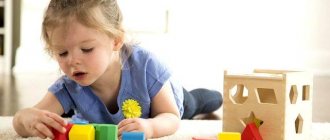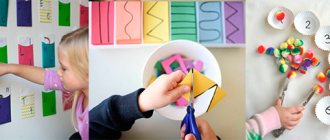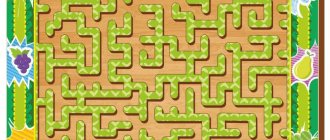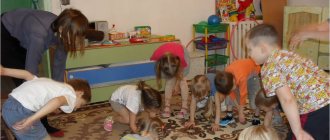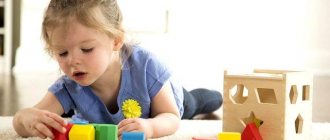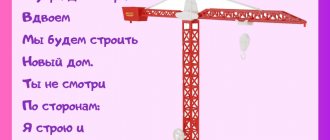"Me and my health." Valeological games and exercises
According to the World Health Organization, “health is a state of complete physical, mental and social well-being and not merely the absence of disease or injury.”
A number of factors influence a child’s health:
- heredity (share of influence is 20%)
- environmental impact (share of influence - 20%)
- medical care (share of influence - 10%)
- lifestyle (share of influence - 50%).
These data force us to pay the most serious attention to the fourth group of factors. It consists of the child’s attitude to his health, his nutrition, adherence to the daily routine, physical activity, hardening, proper sleep, and mastery of hygiene skills. The games and exercises offered in this section will help children develop the right attitude towards their health.
Who do I look like? Goal: developing the ability to look at oneself from the outside, compare a person with other animal organisms, find similarities and differences, promote the development of imagination.
Material: photographs of parents, other close relatives of children, prizes.
Description: invite children to carefully look at the photographs and find similar features. The one who finds the most signs wins a prize.
Who was born
Goal: to consolidate children’s ideas about how living beings are born.
Equipment: three large pictures depicting an egg, caviar, a bottle of milk and a pacifier; small pictures depicting people, animals, birds, amphibians, insects.
In front of the children are pictures with animals, insects, amphibians, and people turned upside down. Children choose any picture and tell how this creature was born. Then they combine a small picture with a large one - with the image of an egg, an egg, a bottle with a nipple (for mammals).
Gardener
Goal: familiarization with the external structure of the human body, to develop the ability to see the good in other people.
Description: children stand in a circle, the leader is the gardener in the center. He utters the following words: “I was born a gardener, I was seriously angry, I was tired of all the flowers, except for Yulenka! “Then the “gardener” talks about Yulenka’s virtues. Then Yulenka becomes the leading gardener. She chooses one of the guys and tells why he (s) is good, thus explaining her choice.
Name it correctly
Goal: to consolidate knowledge about hygiene products, their purpose and correct use.
Material: subject pictures of various subjects, including images of hygiene products, chips.
Description: children choose from a variety of items those that help them take care of themselves. For example: “I wash my face” (what objects help you with this), “I take a shower,” etc. For the right choice - a trick.
Choose clothes according to the seasons
Goal: developing the ability to distinguish items of clothing depending on the time of year.
Material: items of clothing used in different seasons, 4 dolls.
Description: children are divided into teams, each of which “dresses” its doll for a certain time of year.
Who needs what to live?
Goal: consolidation of knowledge and ideas about the basic needs of living organisms for warmth, air, food, habitat.
Material: cards depicting living beings (human, dog, tree, flower, etc.; cards depicting food, habitat.
Description: invite children to choose a pair for each card, answering the questions - choose what the bird needs to live? What does a dog need so that it can live.
Who am I?
Goal: expanding the child’s knowledge about himself, his name, his surname, age.
Equipment: mirror; subject pictures depicting animals and birds.
Tell us what you know about yourself (name, age, height, hair color and length, eye color, date of birth, girl or boy).
Tell me who you are like: mom or dad.
Do you have signs that are present in any animal or bird?
Health traffic light
Goal: developing ideas about a healthy lifestyle.
Material: circles of red, yellow, green colors, subject pictures.
Description: offer to “light” the health traffic light. The green circle is what helps a person lead a healthy lifestyle; yellow is something that needs to be treated with caution, red circle is something that is harmful to health.
Name the athlete
Goal: to develop a respectful attitude towards athletes, to develop the ability to distinguish and name sports.
Material: pictures of athletes.
Goal: to develop a respectful attitude towards athletes, to develop the ability to distinguish and name sports.
Description: Children play in pairs. One takes a picture of an athlete and shows the given sport with a movement, the other guesses. Then the players change places.
Where are the vitamins hidden?
Goal: to consolidate the understanding of vitamin groups, their importance and health benefits.
Material: baskets with letters indicating groups of vitamins (A, B, C); dummies of fruits and vegetables.
Description: suggest placing the dummies in baskets with the corresponding group of vitamins.
What first - what then (daily routine)
Goal: to reinforce the idea that following a proper daily routine is good for health.
Material: plot pictures depicting actions characteristic of a certain period of the day.
Description: invite players to arrange the pictures in the correct sequence and explain their choice.
Sun, air and water are our faithful friends
Goal: to form an idea about the means and types of hardening (water, air, solar), their importance for health.
Material: story pictures.
Description: children look at the pictures and determine what health benefits the sun, air and water bring. The one who names the most useful properties wins.
Why did the guys get sick?
Goal: to develop the ability to identify cause-and-effect relationships, cultivate a caring attitude towards one’s health, and develop coherent speech.
Material: plot pictures depicting correct and incorrect actions (leading to illness).
Description: children choose pictures depicting incorrect actions and explain their choice.
Name it correctly (medicines)
Goal: familiarize yourself with the names of medications that are used for treatment and which are part of the “home medicine cabinet.”
Material: pictures depicting medications included in the “home first aid kit”, “first aid kit”.
Description: children are invited to assemble a “home first aid kit”, naming medications, and explain their choice.
Choose medicinal plants
Goal: familiarize yourself with the names of medications that are used for treatment and which are part of the “home medicine cabinet.”
Material: subject pictures depicting plants, “Aibolit” doll.
Description: children choose medicinal plants from all the proposed pictures, and “Aibolit” explains what medicinal properties they have.
How should you take care of yourself?
Goal: developing skills to monitor compliance with personal hygiene rules.
Equipment: top, chips, cards with questions.
The presenter spins the top, which determines the card with the question. For the correct answer, the child receives a chip. The one with the most chips wins.
Questions
1. Name the items you need for washing (soap, towel).
2. Name the items you will need to take a shower (shampoo, soap, shower gel).
3. How often should you wash? (Every day).
4. How often should you brush your teeth? (In the morning and in the evening).
5. How often should you cut your nails? (At least once every 10 days).
6. How often should you wash your ears? (Every day).
7. How often should you change your underwear? (Every day).
Show me and I'll guess
Goal: to develop a respectful attitude towards athletes, to develop the ability to distinguish and name sports.
Description: one subgroup of children, using specific movements, shows (makes a guess) what kind of sport they are involved in. Another subgroup guesses who was depicted (skier, swimmer, hockey player, gymnast, etc.).
Good words
Goal: to create a desire to see the good in other people, the development of speech and imagination.
Description: children stand in circles, pass the ball around the circle, name one of the good qualities of their neighbor or call him by an affectionate name.
Making a menu
Goal: developing the idea that health depends on proper nutrition - food should not only be tasty, but also healthy.
Material: play dishes, dummies of fruits, vegetables, food.
Description: The presenter tells the players: “In front of you is a table set for lunch (dinner). Put in the first plate what you want to eat first, then fill the second plate, and the dessert bowl. Mark those players who filled their plates with more than just sweets, and who “created a menu” that is healthy.
To keep your skin healthy
Goal: developing skills to monitor compliance with personal hygiene rules.
Equipment: pictures marked with a red rim with incorrect actions of children.
Children look at the pictures and find what is wrong. For the correct answer, the child receives a chip. The one with the most chips wins.
Images
The child licks abrasions and cuts.
Boy in dirty underwear.
The girl puts on someone else's shoes.
What do we know about things?
Goal: to expand children’s understanding of the rules of safe behavior at home; develop attention and memory; foster a sense of cooperation.
Material: four playing cards depicting a cut, burn, hand bruise and fire; pictures depicting various household items.
Description: 4 children take part in the game, each of them takes a game card with the image of an “injury”. The teacher (child) is the leader. He picks up a picture of an object one by one. Participants must guess what injury could result from improper handling of this item, match it to their card and take the picture. When selecting, the child must explain why this or that object is dangerous and tell the rules for handling it.
Author: Olga Vladimirovna Mozdukova, teacher at MBDOU “Kindergarten No. 3”, Belovo, Kemerovo region, Russia.
The article is published in the author's edition.
Card index of didactic games on valeology
CARD FILE OF DIDACTIC GAMES ON VALEOLOGY
For children of senior preschool age
Where does the vitamin live?
Didactic task:
introduce children to the types of vitamins and their sources.
Game rules:
You need to choose a picture and name what vitamins are in this fruit or vegetable.
Game actions:
selecting cards and matching them with the image of a vegetable or fruit.
Progress of the game
:
The teacher invites the children to divide into two teams. The player of the first team shows the vitamin, and the players of the other team show pictures of vegetables and fruits that contain it. Then it’s the other way around: the player of the second team shows a picture of a fruit or vegetable, and the players of the first team name the vitamins that it contains and show the corresponding picture.
What does the heart love?
Didactic task:
instill the habit of a healthy lifestyle, broaden children’s horizons on the prevention of heart disease.
Game rules:
You need to name the type of product or type of activity that is good for the heart.
Game actions:
naming words and connecting parts of the heart into a whole.
Progress of the game:
The teacher asks the children to name types of foods and activities that are good for the heart. Each named word is a part of the heart. Gradually, as children name words, a whole heart is formed. Number of players 8-10 people.
The morning begins...
Didactic task:
to accustom children to following a daily routine, to consolidate activities carried out at different times of the day.
Game rules:
It is necessary to name the activities carried out in the morning, afternoon, evening, and night.
Game actions:
choosing pictures and naming activities corresponding to morning, afternoon, evening and night.
Progress of the game:
The teacher invites the children to choose a picture of the time of day and name the corresponding activities that need to be carried out at this time of day and arrange the cards in the sequence in which they should be performed. Number of players 8-10 people.
Health watch
Didactic task:
consolidate children's knowledge about harmful and healthy foods and activities.
Game rules:
You need to scroll the arrows on the “health clock” and determine the usefulness or harmfulness of the image.
Game actions:
determining the usefulness or harmfulness of an image in a picture.
Progress of the game:
Option 1. The teacher invites the children to take turns scrolling the arrows on the “health clock”, while periodically saying: “Stop.” The player stops the arrow on the “health clock”, looks at the image to which it is directed and talks about the usefulness or harmfulness of what is in the picture. Number of players 8-10 people.
Option 2. Combine the two circles of the clock and match the options for the pictures. For example, during class, do not shout or watch TV for a long time before going to bed.
Health tree
Didactic task:
consolidate children's knowledge about harmful and healthy foods.
Game rules:
You need to distribute the pictures on the pieces of paper into the corresponding trees.
Game actions:
determining the usefulness or harmfulness of an image in a picture.
Progress of the game:
The teacher invites the children to divide into two teams, choosing a tree of “health” or a tree of “illness” and turns on light music.
While the music is playing, the children hang leaflets with pictures on the corresponding trees. When the music stops, the teacher sums up the task. Number of players 8-10 people.
Health with indoor plants
Didactic task:
consolidate children's knowledge about indoor plants, their names and beneficial properties.
Game rules:
You need to choose from a number of pictures pictures of indoor plants, name them and list their beneficial properties.
Game actions:
naming the plant and determining its usefulness.
Progress of the game:
The teacher invites the children to choose inverted pictures one by one. Having examined the image in the picture, the child needs to name the houseplant and list its beneficial properties. After completing the task, the child receives a chip. The one with the most chips wins. Number of players 8-10 people.
Be healthy
Didactic task:
form the habit of a healthy lifestyle, consolidate children’s knowledge about healthy products and activities.
Game rules:
You need to choose a picture depicting a food product and a type of activity in turn and correlate them with each other.
Game actions:
correlation of food product with type of activity.
Progress of the game:
The teacher invites the children to choose, for example, a picture of a carrot and an athlete and correlate them with each other: the athlete chooses healthy vegetables for nutrition, etc. (Fig. 7). Number of players 8-10 people.
Health and color
Didactic task:
learn to create a certain mood for a certain type of activity using color.
Game rules:
It is necessary to correlate a certain color with a certain type of activity.
Game actions:
correlating color with the corresponding type of activity.
Progress of the game:
The teacher invites the children to choose a color and correlate it with the corresponding type of activity:
Red – exciting, energetic (classes, exams, sports);
Yellow – when the eyes work hard (writing, drawing, reading);
Blue, light blue – during intense physical activity (rest after physical activity); Purple – accelerates regeneration processes (fast healing after illness); Orange – to overcome lethargy (sing, dance); Green – to create a positive emotional background (bedroom, relaxation);
MY FACE
Goals:
Teach knowledge of yourself, your individuality. Teach children how to make a human face (using various objects). Develop fine motor skills of the hands. Reinforce children's concepts of color (blue, green, gray, brown eyes). Strengthen the idea of parts of the face; activate the vocabulary: eyes, mouth, lips, nose, eyebrows. Develop tactile sensations.
Material:
multi-colored braid, buttons, sticks, plasticine, sandpaper, velvet paper, foam rubber.
Content.
Using various materials, children make up a person or his face; give a descriptive story about the face, its shape, etc.
CLEAN HANDS
Goals:
Teach the sequence of actions of the washing process. Activate the dictionary: soap, washcloth, brush, towel. Form the need for compliance with personal hygiene rules. Teach practical development of healthy lifestyle skills.
Material:
pictures with rules, toiletries, small toys, three-dimensional animal figurines, labor items.
Content.
1st option
– the teacher invites the children to choose pictures that correspond to the rule when it is necessary to wash their hands, and according to the picture, find three-dimensional objects.
2nd option
– the teacher invites children to imitate the movements of the washing process (creativity and imagination develops).
LET'S TALK WITHOUT WORDS
Target.
Exercise children in understanding the meaning of certain gestures, postures, and facial expressions of a person.
Content.
The teacher invites the children to guess the meaning of his gestures
(greeting, farewell, threat
, etc.), facial expressions
(surprise, joy, anger
, etc.), posture
(confusion, fatigue, well-being
, etc.). Then the children are given the task of giving examples of using various gestures, changing posture and facial expressions in order to understand each other without words.
FIND A PAIR
Goals:
Exercise children in selecting identical plates, comparing their surfaces using tactile sensations (blindfolded).
Content.
Plates covered with foil, velvet paper, fur, flannel, silk, as well as metal and wooden plates are placed in front of the children. Children choose one plate at a time, and then take turns looking for the second one by touch.
Note.
The child must explain what helped him correctly identify different materials.
I CAN – I CAN’T
Goals:
Intensify children's attention to their skills and physical capabilities of their body. Develop research activities, cultivate self-esteem.
Content.
Any number of children can participate in the game (from 1 to 10).
The presenter throws the ball to the child and says: “I can” or “I can’t.” The child, having caught the ball, must continue the phrase, explaining why he knows how to do it (what helps him) or does not know how to do it (can he learn), and return the ball to the leader. For example:
“I can run because I have legs,” “I can’t fly because I don’t have wings.”
IDENTIFY BY TOUCH
Target.
Exercise children in guessing familiar objects by touch, naming the characteristics of this object.
Content.
The child must identify the object in the “wonderful bag” by touch and characterize it, highlighting as many features as possible. The teacher offers to name the color of the object and finds out why it is impossible to do this. In order to complicate the game in the bag, you should put only one item for guessing, after showing it to the other children. For each correct answer, a chip is awarded.
ALL HELPERS ARE IMPORTANT
Goals.
Activate children's knowledge about the dominant development of a particular sense organ for people of a certain profession.
Activate the vocabulary: cook, intelligence officer, conductor, perfumer, magician.
Content.
Each player receives a large card with a picture of a person of a certain profession.
On the table there are small cards with the image of one or another sense organ. Players take turns taking out one small card at a time and either keeping it if it matches the image on the large card (i.e. if this sense organ is important for people of this profession), or returning it back. (For example:
for a large card with a picture of a perfumer, the child matches a small card with a nose on it.) The game ends when each player has one small card corresponding to the big one. Players then take turns justifying their choice. The rest of the players listen carefully and evaluate the correctness. The winner is the one who did not make a single mistake or made a minimum number of inaccuracies.
Note.
The number of cut cards should be more than necessary. You can offer a game option in which each child has the right to choose several large cards. This becomes possible as preschoolers acquire relevant knowledge about the peculiarities of the development of a certain sense organ in people of different professions.
WHO COUNT THE BUTTONS FASTER
Target.
Intensify children's attention to the fact that a large number of analyzers involved in the work make it easier to perform any work.
Content.
The child is asked to count the number of buttons on his shirt (jacket, dress, coat, fur coat) in two ways: only by touch or by feeling and looking at them.
Note.
Talk with the children about in what case it turns out to count faster and why.
LET'S LISTEN TO YOUR BODY
Target.
Introduce children to basic relaxation techniques, which have a positive impact on well-being and self-awareness.
Content.
The teacher invites the children to sit or lie down comfortably, close their eyes, relax (relax their arms, legs, whole body), listen to themselves, how the internal organs of the body work (how the blood pulsates in time with the beats of the heart, how smoothly we breathe while in calm state, etc.).
IDENTIFY BY SOUND
Target.
Exercise your hearing organs in identifying and distinguishing different sounds.
Content.
To play the game, children are divided into two teams and sit with their backs to the teacher. The teacher imitates various sounds using various objects and instruments. To do this, you can use musical instruments, paper, foil, an inflatable balloon, glass and metal dishes, a pump for inflating balls, a rubber squeak toy, etc. Players from each team take turns guessing the sound. The winning team is the one that gives more correct answers and makes fewer mistakes. For each correct answer, the team receives a chip.
GUESS WHO CALLED
Target.
Train the hearing organs and activate the attention and auditory memory of children.
Content.
The driver, standing with his back to the players, must determine who called him (or said the word “meow”). If the answer is correct, the leader’s place is taken by the child whose vote was determined.
To make the game more difficult, you can give children a rattle. The teacher points to the next player who must rattle his rattle. The driver determines which of the game participants rattled the rattle. In this case, the driver can stand in a circle, his eyes should be closed.
GUESS WHERE THE BEAR TRAVELED
Target.
Using tape recordings, train children in the perception of various sounds.
Content.
Children are invited to listen to recordings of the rustling of leaves, birdsong, sounds made by trains and cars, the sound of the sea surf, etc. The children must guess the sounds they hear and tell what thoughts they evoke.
DON'T MISS YOUR SOUND
Goals.
Develop children's phonemic hearing.
Content.
The teacher invites each child to be the house of some sound (the children themselves choose and name whose house they will be). To do this, they choose a badge with the image of any sound of the Russian language ([р], [о], [y], etc.). While listening to a poem (story), children determine the first sound of each word. Having heard a word with its “own” sound, the child needs to quickly get up and sit down. The teacher monitors the correct completion of the task.
SAY QUIET, SAY LOUD
Goals.
Develop children's hearing. Intensify their attention to the strength of their voice, at which their speech will be clearly heard. Form a culture of speech.
Content.
The driver stands at a distance of 3-4 meters from other children and gives commands to the players, periodically changing the strength of his voice. Children follow commands. Then the adult finds out why the children performed some commands incorrectly. The guys come to the conclusion that commands need to be pronounced loudly and clearly. And their ears helped them hear the commands.
WHOSE EYES WILL HELP YOU?
Target.
To consolidate children's knowledge about the visual features of living organisms.
Content.
The teacher offers each child a situation to solve which he has the right to “use” the eyes of any animal (walk through a dark cave, count beads, get a pearl from the seabed, etc.).
GAME EXERCISE TO DEVELOP THE EYE METER
Goals.
To develop children's eye, teach them to correlate the size of objects, the length of segments, etc.
Content.
Children are asked to complete a number of tasks. Several children can perform the same task at the same time.
- Mark the center of the circle with a pencil.
- Divide the rectangle in half.
- Draw a line of the same length.
- Cut a strip of the same size.
- Cut out the same shape.
Then the teacher helps to check how correctly and accurately the tasks have been completed, and, if necessary, gives recommendations.
WHAT CAN YOU BITE WITH YOUR TEETH?
Target.
To develop children’s ability to establish the positive and negative effects of foods they eat on their teeth
Content.
Children stand in a circle. The driver, an adult or a child (depending on the age of the children in the group), names objects and products. (For example: stone, bun, cutlet, bone, finger, nut, etc.). Children say “yes” and raise their hands up if it can be bitten with their teeth, or say “no” and squat down if it cannot be bitten with their teeth.
To prepare for the development of tactile sensations, a number of game tasks.
Gaming valeological technologies
Today, health improvement is becoming one of the main social problems, so the science of health - valeology - has begun to develop intensively. Many new books, textbooks, and health programs have appeared, the purpose of which is to teach a child to be healthy physically, mentally, and morally.
I, like any teacher, of course, want to see an initiative person in my student. Without personal activity and interest, neither the development of natural (biogenetic) abilities nor knowledge of the surrounding world is possible. The concept of “initiative personality” includes, first of all, such personality qualities as openness (the desire to establish new contacts), mobility (adjust to the situation), and the ability to self-regulate. But didacticism in preschool education is ineffective. The experience of many thousands of generations has shown that the most effective method of education is play. It is impossible to overestimate the role of a child’s play; the game is the child's life itself.
The new (valeological) direction requires new methodological developments: for me, gaming valeological technologies became them. Only by using a leader for a child’s play activity can I give him health, making it interesting, fun, and for life.
The main goal of valeological games is to form ideas about a healthy lifestyle. These games combine educational and recreational goals. Without the closest cooperation between general medicine and general pedagogy, there is no guarantee not only of lasting vital results, but also of the formation and consolidation of biological and social stability and high mobility of the child’s body.
Based on the basic principles of valeological education, three areas of valeological games can be distinguished.
Matrix games.
These are integrated games that combine the capabilities to solve a large number of educational and recreational tasks, united by a common block theme. The choice of a specific topic will vary depending on the tasks that I set for myself based on my program. Mental, emotional state of children and other factors.
The matrix is the basic model. It can be presented in the form of a residential building, or a castle with rooms, halls, playgrounds, with corresponding characters, attributes, and game tasks. This structure of the basic model provides wide creative opportunities for my work both in studying topics (hygiene rules, nutritional culture, etc.) and in generalizing knowledge on block topics (daily routine, sports, etc.) .
Matrix games are designed for use in various age groups. First, children are given primary knowledge about individual concepts, and then, thanks to the mobility of the basic model, this knowledge is expanded and consolidated.
An example is the valeological matrix game “House of the Dwarves”, which is designed in the form of a house of six rooms (entrance hall, living room, bathroom, bedroom, playroom, kitchen).
For example, if I take the main topic “Daily Routine”, then topics such as “Nutrition”, “Clothing”, “Cultural hygiene skills”, etc. are considered separately. At the first stage, an acquaintance takes place with the “owners” of the house, the gnomes and Snow White. Then, based on the set goal, we get acquainted with how the day goes in the house (consolidating and forming knowledge about the need to adhere to the daily routine), or we stop in one of the rooms to play “inside” it. (“Help Snow White set the table”, “Gather the gnomes for a walk”, etc.).
Travel games
When introducing children to the internal structure of the human body, I often had difficulties. It was not always interesting and even unpleasant for children to examine the anatomical structure of the internal organs and systems of the body. When I started using an anatomical atlas for preschoolers, where the main systems and internal organs of a person are presented in the form of colorful
. fairytale maps, activities turned into a game with travel around the map. The inhabitants of the magic map talk about themselves in a funny and accessible way. About what they love and what harms them.
In this way, children not only absorb the scientific knowledge available to them. But they develop a desire to help their body be healthy.
First, I invite children to get acquainted with the structure and functions of individual organs, and then take them on a journey through one of the systems, consolidating knowledge about its components and its work.
The science-fiction plot of the journey leads children to the idea that every organ of the human body is important and necessary, that all organs are interconnected and act together.
I conduct travel games in the preparatory group on the topics: “The Journey of the Pie” (introduction to the digestive system), “The Journey of Prince Oxygen” (introduction to the respiratory system), “We are captains” (introduction to the circulatory system).
Valeological tales
New knowledge about the structure of a person, the functions and work of internal organs should be of practical importance for the child. The main idea of valeological fairy tales comes down to the main task - to teach a child to be healthy. Fairy tales model situations related to the causes of illnesses, injuries, and practical lessons on how to avoid these troubles and what to do if trouble does occur.
I don’t just read fairy tales to children, but always act them out (finger theater, flannelgraph). The brightness of the images helps to enliven the plot and make it more visual. It is easier for children to “enter a fairy tale and complete it”, figuring out how to help the main character. In this way, a model of correct behavior is formed in children.
In the future, when faced with a similar situation, they will be ready for it, they will know what to do and how to behave.
Psychologists have long been using the fairy tale therapy method in their work and have proven its effectiveness, especially in cases where it is necessary to help a child overcome internal fears about visiting a doctor, injections, etc.
